301B Online Practice Questions and Answers
An LTM Specialist must perform a hot fix installation from the command line.
What is the correct procedure to ensure that the installation is successful?
A. import the hot fix to the /var/shared/images directory check the integrity of the file with an md5 checksum tmsh apply sys software hotfix volume
B. import the hot fix to the /var/shared/images directory check the integrity of the file with an md5 checksum tmsh install sys software hotfix
C. import the hot fix to the /shared/images directory check the integrity of the file with an md5 checksum tmsh apply sys software hotfix volume
D. import the hot fix to the /shared/images directory check the integrity of the file with an md5 checksum tmsh install sys software hotfix
A new VLAN vlan301 has been configured on a highly available LTM device in partition ApplicationA. A new directly connected backend server has been placed on vlan301. However, there are connectivity issues pinging the default gateway. The VLAN self IPs configured on the LTM devices are 192.168.0.251 and 192.168.0.252 with floating IP 192.168.0.253. The LTM Specialist needs to perform a packet capture to assist with troubleshooting the connectivity.
Which command should the LTM Specialist execute on the LTM device command line interface to capture the attempted pings to the LTM device default gateway on VLAN vlan301?
A. tcpdump -ni /ApplicationA/vlan301 'host 192.168.0.253'
B. tcpdump -ni vlan301 'host 192.168.0.253'
C. tcpdump -ni /ApplicationA/vlan301 'host 192.168.0.251 or host 192.168.0.252'
D. tcpdump -ni vlan301 'host 192.168.0.251 or host 192.168.0.252'
An LTM Specialist is setting up a monitor for an HTTP 1.1 server. The response to a GET / is:
HTTP/1.1 302 Moved Temporarily Location: http://www.example.com/new/location.html Which send string settings should the LTM Specialist use to force a proper response?
A. GET / HTTP/1.0\r\nHost: host.domain.com\r\nConnection: Close\r\n\r\n
B. GET /new/location.html HTTP/1.1\r\nHost: www.example.com\r\nConnection: Close\r\n\r\n
C. GET / HTTP/1.1\r\nHost: www.example.com/new/location.html\r\nConnection: Close\r\n\r\n
D. GET /new/location.html HTTP/1.1\r\nHost: host.domain.com/new/locations.html\r\nConnection: Close\r\n\r\n
An FTP monitor is NOT working correctly.
Which three pieces of information does the LTM Specialist need to provide to ensure a properly working FTP monitor? (Choose three.)
A. alias
B. File path
C. username
D. password
E. FTP server port
F. FTP server IP address
An LTM Specialist configures two LTM devices in a high-availability pair with trusts established and device groups configured properly using network failover. After several months, the LTM Specialist notices that changes made to one LTM device do NOT cause the synchronization status to update to "changes pending," and this device does NOT synchronize with the device group.
Which two steps should the LTM Specialist take to identify the issue? (Choose two.)
A. Verify that NTP is synchronized.
B. Verify the network connectivity between the devices.
C. Verify that the devices are not using self-signed certificates.
D. Verify that ConfigSync is using the management IP address.
E. Verify that port lockdown on the ConfigSync interface is set to allow port 1026.
-- Exhibit
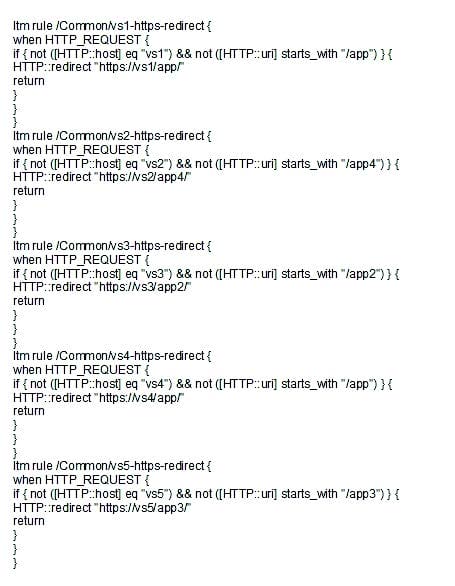
-- Exhibit -Refer to the exhibit.
Which two items can be consolidated to simplify the LTM configuration? (Choose two.)
A. /Common/vs1-https-redirect
B. /Common/vs2-https-redirect
C. /Common/vs3-https-redirect
D. /Common/vs4-https-redirect
E. /Common/vs5-https-redirect
-- Exhibit

-- Exhibit -Refer to the exhibit.
An LTM Specialist is upgrading the LTM devices.
Which device should be upgraded first?
A. Device A
B. Device B
C. Device C
D. Device D
-- Exhibit

-- Exhibit -Refer to the exhibit.
Which step should an LTM Specialist take next to finish upgrading to HD1.3?
A. Install image to HD1.3
B. Install hotfix to HD1.3
C. Activate HD1.3
D. Relicense HD1.3
-- Exhibit -
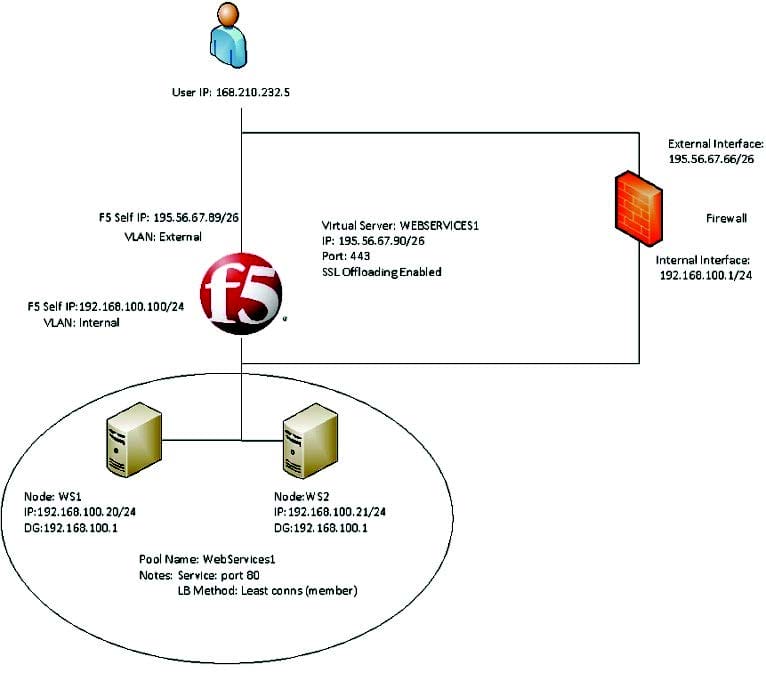
-- Exhibit -Refer to the exhibit.
A company uses a complex piece of client software that connects to one or more virtual servers (VS) hosted on an LTM device. The client software is experiencing issues. An LTM Specialist must determine the cause of the problem.
The LTM Specialist is seeing a client source IP of 168.210.232.5 in the tcpdump. However, the client source IP is actually 10.123.17.12.
Why does the IP address of 10.123.17.12 fail to appear in the tcpdump?
A. The LTM device performed NAT on the individual's IP address.
B. The Secure Network Address Translation (SNAT) pool on the virtual server is activated.
C. Network Address Translation (NAT) has occurred in the path between the client and the LTM device.
D. The individual's data stream is being routed to the LTM device by a means other than the default route.
-- Exhibit
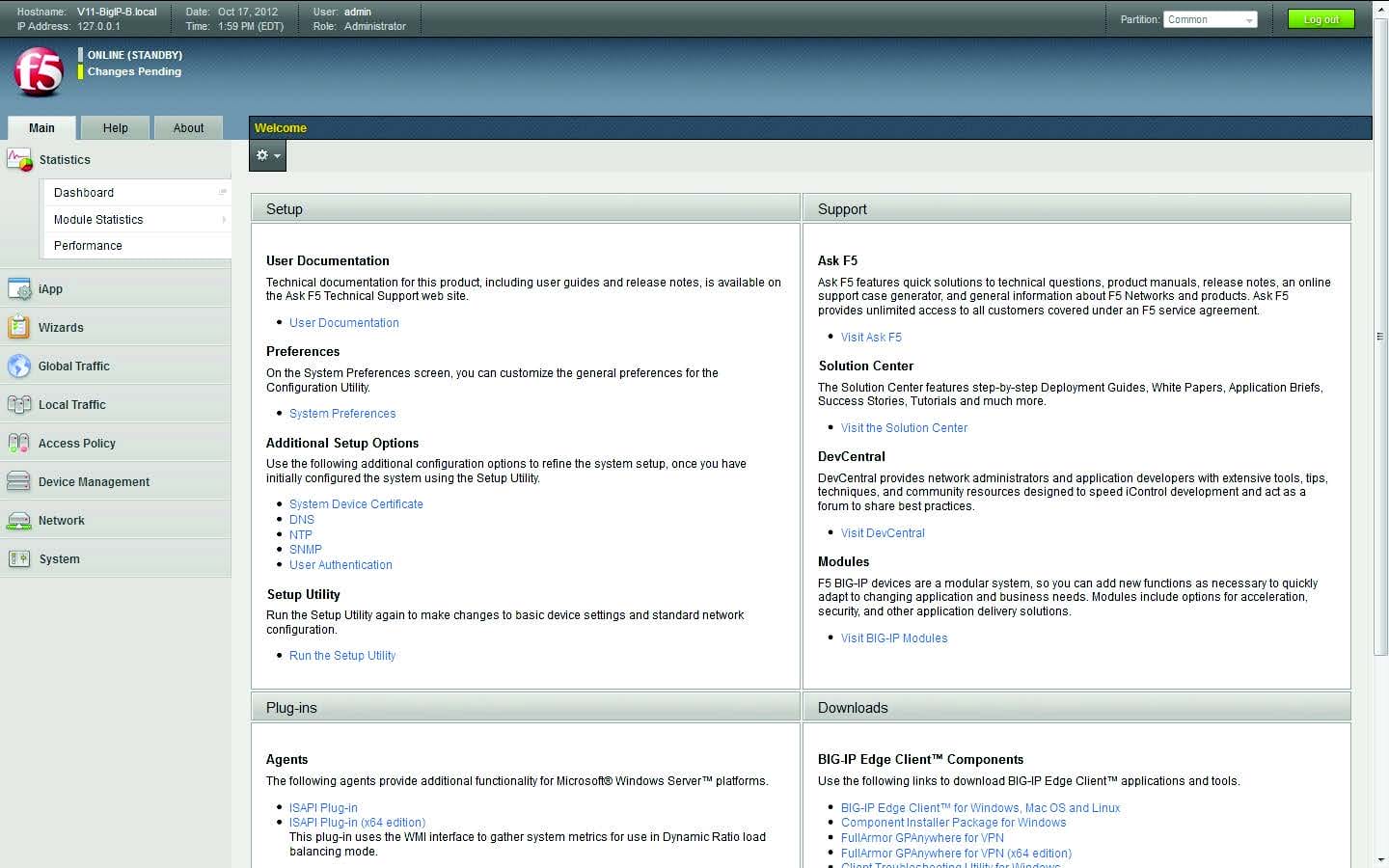
-- Exhibit -Refer to the exhibit.
Which step should an LTM Specialist take to utilize AVR?
A. provision AVR
B. reboot the device
C. install the AVR add-on
D. license the device for AVR
-- Exhibit
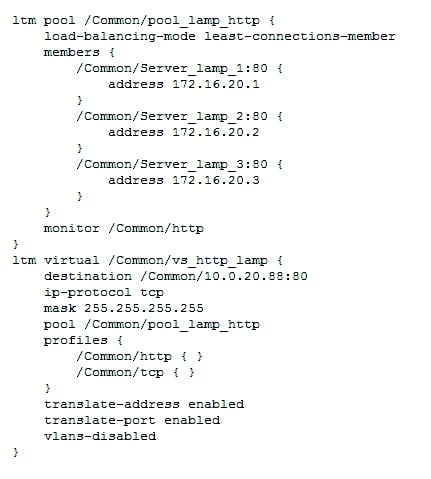
-- Exhibit -Refer to the exhibit.
Users report that a web application works incorrectly. Sometimes contextual data displayed on the web pages is accurate; other times it is inaccurate.
The LTM administrator looks at the connection table with a filter on one of the client IP addresses currently connected using the command "tmsh show sys connection cs-client-addr 10.0.20.1"
with the following results:
10.0.20.1:60048 10.0.20.88:80 10.0.20.1:60048 172.16.20.1:80 tcp 3 (tmm: 0) 10.0.20.1:60050 10.0.20.88:80 10.0.20.1:60050 172.16.20.3:80 tcp 3 (tmm: 0) 10.0.20.1:60047 10.0.20.88:80 10.0.20.1:60047 172.16.20.2:80 tcp 3 (tmm: 0)
10.0.20.1:60049 10.0.20.88:80 10.0.20.1:60049 172.16.20.1:80 tcp 3 (tmm: 0)
What is the solution to the problem?
A. Synchronize the clock of the LTM device with NTP.
B. Modify the load balancing method attached to the pool.
C. Set up an HTTP cookie insert profile in the virtual server.
D. Modify the setup of the monitor bound to the pool used by the application.
-- Exhibit
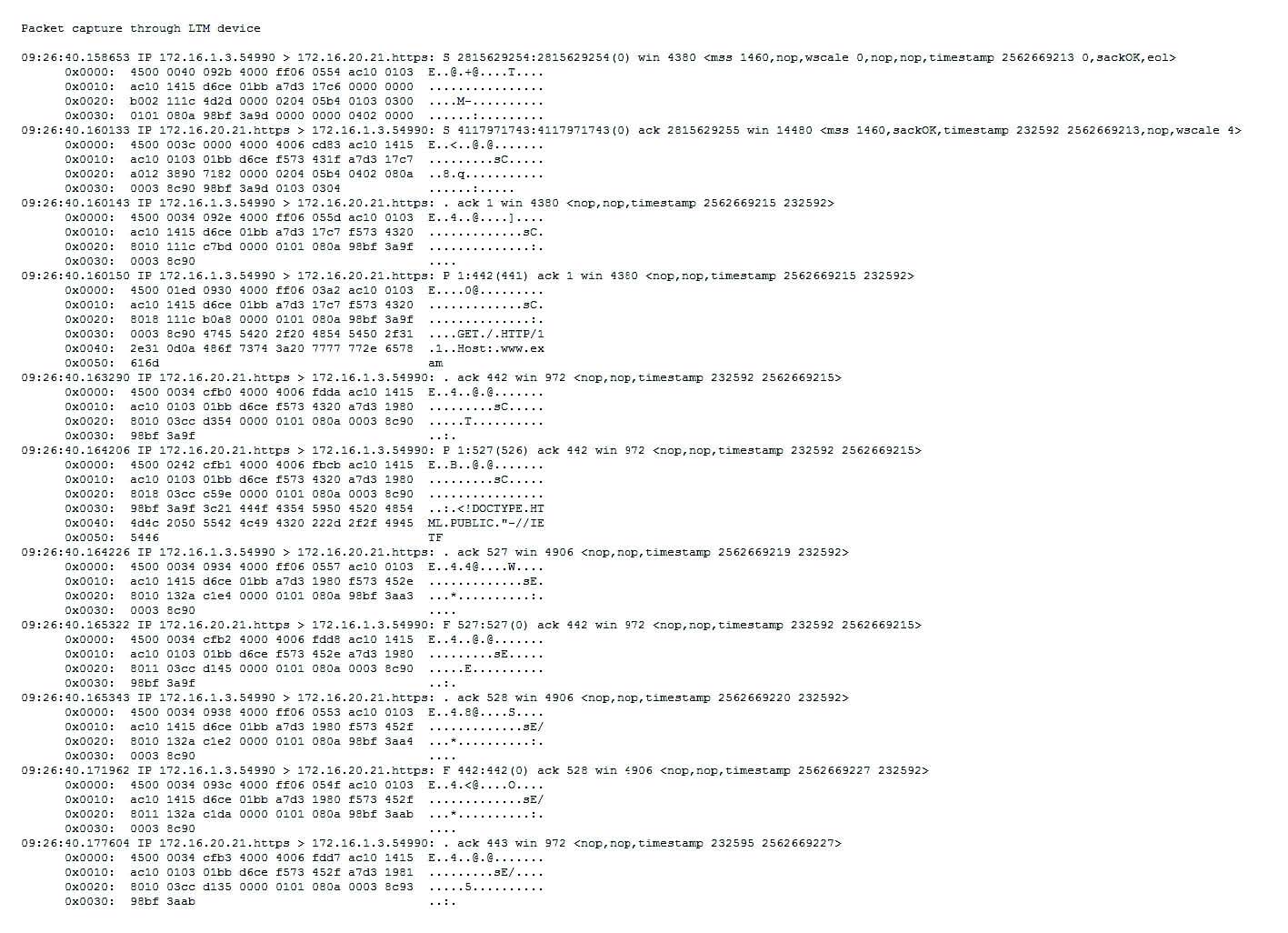

-- Exhibit -
Refer to the exhibits.
An LTM Specialist has configured a virtual server to distribute connections to a pool of application servers and to offload SSL processing. The application fails to work as expected when connecting to the virtual server. It does work when
clients connect directly to the application. Two packet captures were taken at the application server.
What is the root cause of the problem?
A. The application servers are NOT listening on port 80.
B. The LTM device is sending non-SSL traffic to an SSL port.
C. The virtual server does NOT have a clientSSL profile assigned.
D. The SSL handshake between the LTM device and the server is failing.
-- Exhibit -- Exhibit -Refer to the exhibit. An LTM Specialist is troubleshooting an issue with an application configured on an LTM device. The application works properly when accessed directly via the servers; however, it does not work when accessed via the LTM device. The virtual
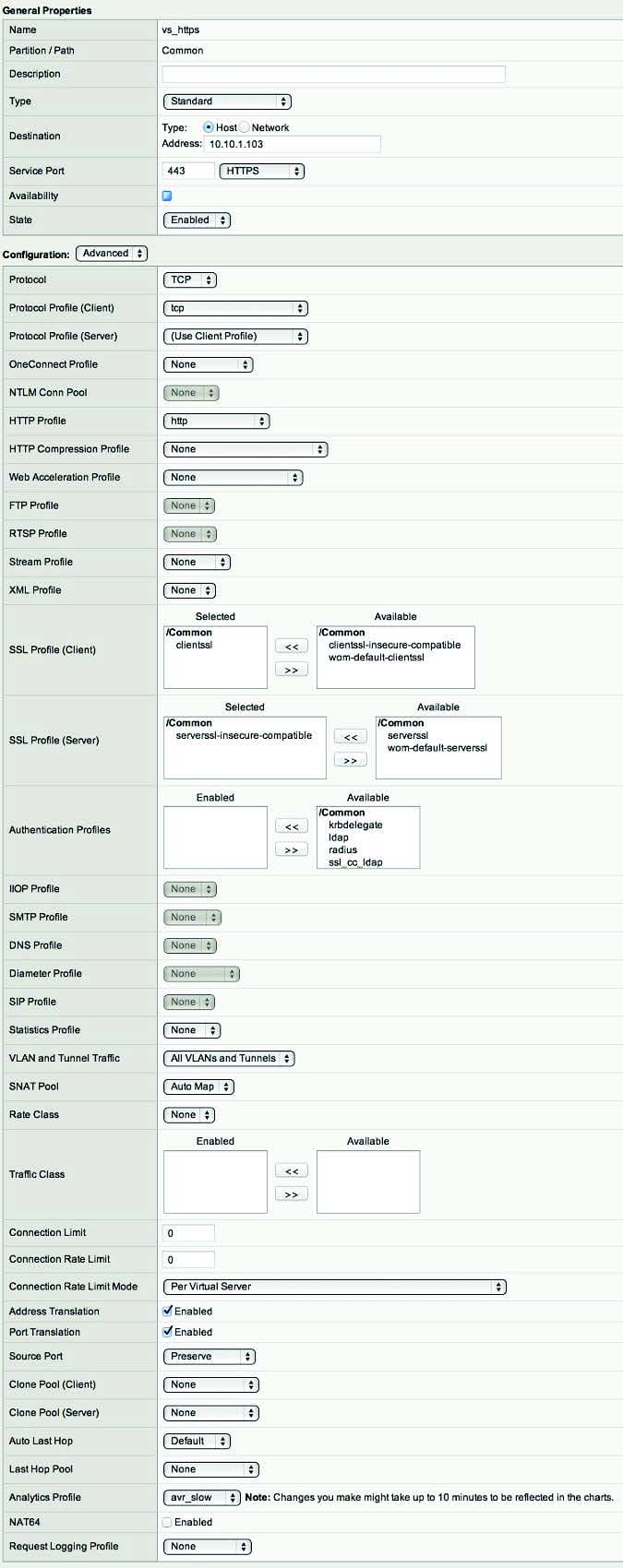
server, 192.168.1.211:443, is configured to SNAT using the address 192.168.1.144 and references a pool with the member 192.168.10.80:443. The virtual server has no Client or Server SSL profiles associated. Which configuration change will allow the application to function through the virtual server?
A. Change pool member port to 8443.
B. Change virtual server port to 8443.
C. Add SSL off-loading to the pool member.
D. Add Client and Server SSL profiles to the virtual server.
-- Exhibit
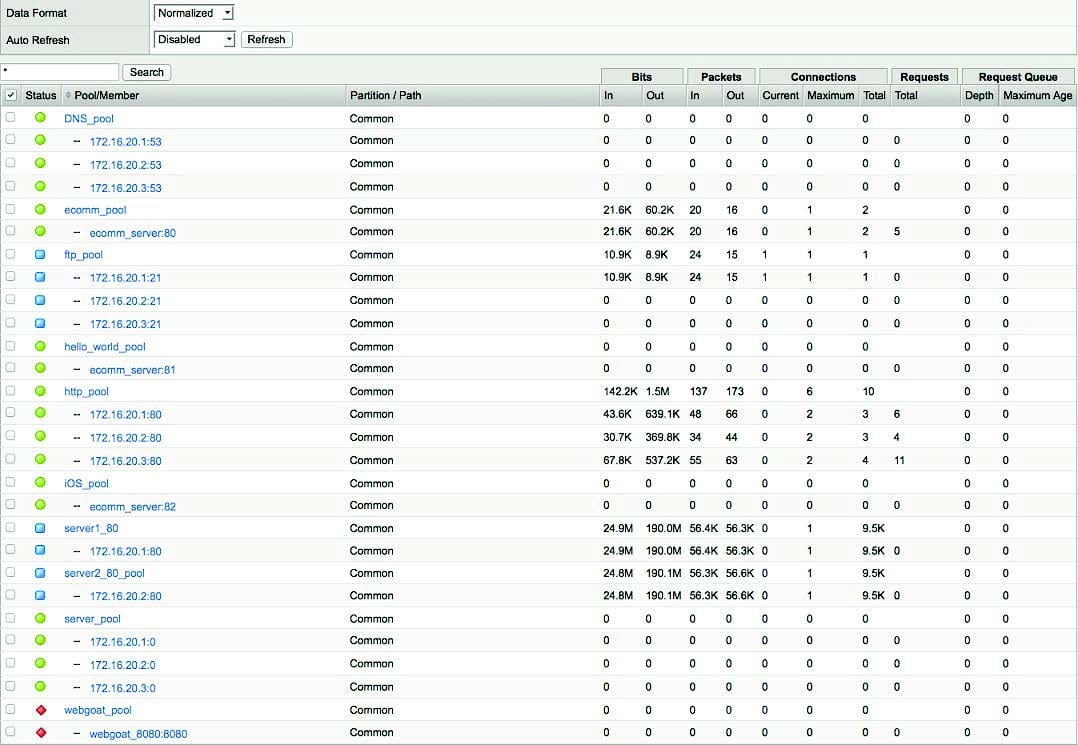
-- Exhibit -Refer to the exhibit.
An administrator created a monitor to a pool member web server, which resulted in a pool member that is marked red. The administrator knows the web server is working when it is accessed from another computer.
What should the administrator do to correct the problem?
A. Change the default gateway on the server.
B. Create a SNAT in the LTM device configuration.
C. Change the route to the client in the LTM configuration.
D. Change the username and/or password on the monitor.
-- Exhibit -- Exhibit -Refer to the exhibits. An LTM Specialist is troubleshooting an issue with one of the virtual servers on an LTM device, and all requests are receiving errors. Testing directly against the server generates no errors. The LTM Specialist has captured the request and
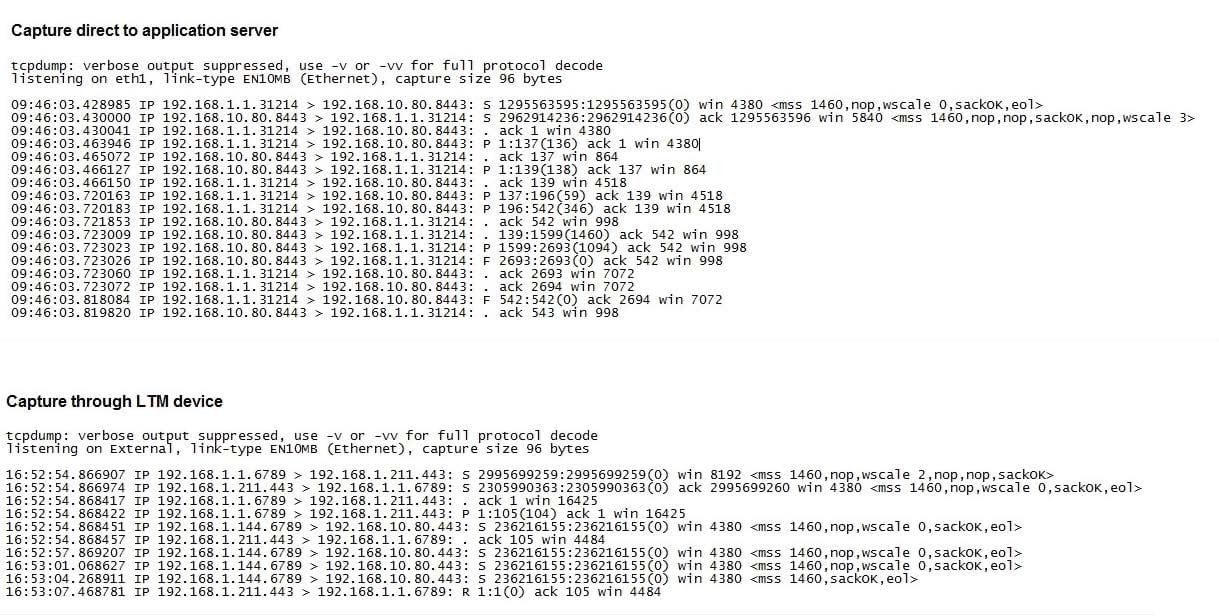
response on both client and server sides of the LTM device. What should the LTM Specialist do to fix this issue?
A. Remove "header-erase Host" in http profile.
B. Configure SNAT Automap on the virtual server.
C. Assign OneConnect profile to the virtual server.
D. Set "redirect-rewrite" to "selective" in http profile.
